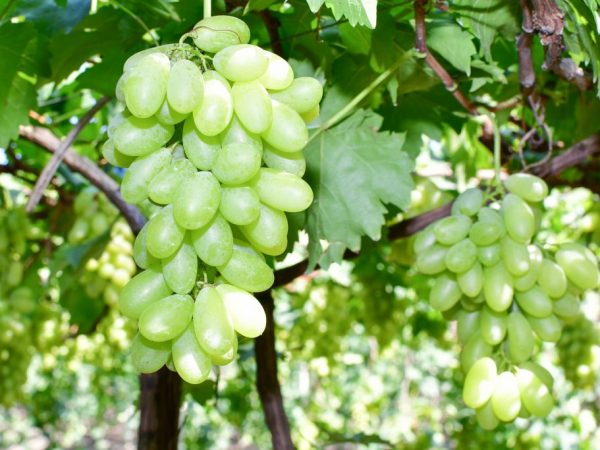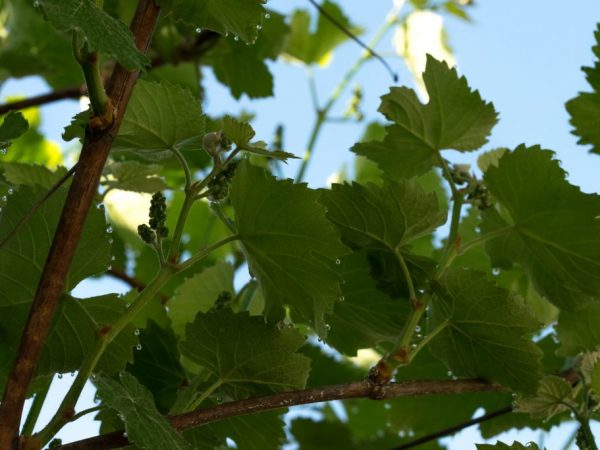Frost-resistant grape varieties
Grapes are one of the first berry crops adapted by humans for growing on a personal plot. The plant is thermophilic, but breeders have bred frost-resistant grape varieties, which became possible to grow in cool climates, for example, in the Moscow region.

Frost-resistant grape varieties
Frost resistance of grapes
Grapes are a southern culture and it is not easy to grow it in the climate of central Russia. When choosing seedlings for planting in these regions, preference should be given to frost-resistant grape varieties that do not need shelter. These species have a short ripening period and withstand frost down to -27 ° C. In addition, uncovered grapes are more resistant to various diseases.
For the most part, frost-resistant grape varieties are used for the production of wines due to their high sugar content and large volumes of juice obtained. But among them there are those that are not inferior in their taste to the best table types. They are also useful for natural shelter for arbors and arches.
Popular frost-resistant varieties
The main characteristics of such varieties include: appearance, taste, ripening period. The most popular frost-resistant crops are:
- Isabel. Table-technical grade. Resistant to pathogens. The fruit of the culture is rounded, dark blue, up to 18 mm in size and weighing no more than 3 grams. The pulp is sweet and sour, with a characteristic odor. Good transportability is noted.
- Riesling. Culture belongs to technical types. It is widely used for the production of white wines and juices. Large berries of a delicate white-green color, rounded, 10-16 mm in diameter. The pulp is sweet, juicy, with a pleasant taste. Due to its high acidity, it retains its fresh appearance for a long time.
- Lydia. One of the most common varieties of frost-resistant grapes. The berry is purple in color, oval in shape, covered with a waxy coating. Diameter no more than 15 mm, weight - 3-4 g. The pulp is dense, slimy, high-calorie, with a characteristic aroma.
- Lady fingers. The name arose from the unique oblong shape of the berries, which reach a length of 4 cm and a weight of 10 grams. Has excellent taste, large clusters and large fruits. The skin is yellow-green in color, with a waxy coating. Many gardeners consider it ideal in terms of taste.
- Laura. Non-covering table variety with long shelf life. The berries are large, light, distinct oval, with a diameter of 30-40 mm, weighing 7-10 grams. The pulp is firm and juicy with a slightly nutmeg flavor. The weight of the bunch reaches 2.5 kg.
- Early pineapple. Universal and one of the earliest non-covering varieties. Fruits are medium in size, oval in shape, with a thin skin, greenish-amber color. Berry weight - 3.8-4.6 gr. It tastes like pineapple. The pulp is slimy.
- Ontario. An open-ended table look with a harmonious taste. The berries are round, weighing about 3.3 grams, sweet.The color from white-green acquires a golden hue as it ripens.
Features of growing and care

Plants are accustomed to frost gradually
Despite the fact that frost-hardy grapes are not afraid of low temperatures, careful care is necessary for them. First of all, you need to choose the right place and time of boarding. The most favorable seasons for such work will be autumn or spring. The planted plants should be watered abundantly 2 times a month. For mature plants, abundant watering in the off-season is optimal.
It is necessary to gradually accustom the seedlings of frost-resistant grape varieties to the cold. The first 3 years they are sheltered for the winter, gradually shortening the period of shelter. In this case, pruning is done 2 times: in the fall - before the onset of frost and in the spring - before bud break. It is carried out to stimulate the growth of young shoots and increase yields. During the growth of the vine, for its faster strengthening, a garter is carried out to the trellis. For non-covering varieties, a standard or arbor form of shoots is carried out.
An important stage is the correct and timely feeding. It is better to make organic feeding in the fall, when digging, and mineral (liquid mineral fertilizers) - in the spring.
Pest and disease control
Frost-resistant grape varieties are immune to pests and diseases, but improper care can cause the vine to become infected. And if the treatment is not started in a timely manner, then you can lose not only the crop, but also the plant itself.
The main task in the fight against diseases of frost-resistant grapes is their prevention.
There are two main types of grape diseases:
- infectious - they are caused by specific fungi, viruses or bacteria that are carried by the wind, work tools. The most harmful and dangerous among them are anthracnose, mildew, oidium, bacterial cancer, gray rot. They are easier to prevent, so it is important not to miss the first symptoms and take timely action. To do this, in the spring, 1-2 times the plant is treated with broad-spectrum fungicides;
- non-infectious - caused by unfavorable weather conditions (strong wind, sharp cold snap, early frosts, prolonged rains). Such diseases are prevented by correct agrotechnical measures and careful care.
Natural enemies of grapes are beetles, larvae, wasps, beetles, bears, cicadas. They damage vines, buds, berries, leaves. These processes inhibit the development of the plant and reduce the volume of the crop. Methods of combating them include mechanical soil cultivation, weed control, manual pest collection, and timely spraying with chemicals.
Conclusion
Cultivation of frost-resistant varieties of homemade grapes in central Russia is carried out both in summer cottages and on an industrial scale. Non-covering species withstand severe frosts, are distinguished by early maturity and good immunity. The culture requires careful maintenance during the active growing season.


